Contemporary Issues in Business Analytics: A Comprehensive Report
VerifiedAdded on 2020/02/24
|15
|3813
|443
Report
AI Summary
This report provides a comprehensive overview of contemporary issues in business analytics, examining core knowledge areas essential for business analysis. It delves into business analysis planning and monitoring, emphasizing techniques for analysis and stakeholder identification. The report explores elicitation and collaboration, detailing how analysts work with stakeholders to understand their needs. Requirement life cycle management, strategy analysis, requirements analysis and design definition, and solution evaluation are also discussed, highlighting the importance of managing requirements, defining business needs, and designing solutions to meet organizational goals. The report emphasizes the iterative and interconnected nature of these processes, underscoring the importance of each area for successful business analysis and the achievement of desired outcomes.
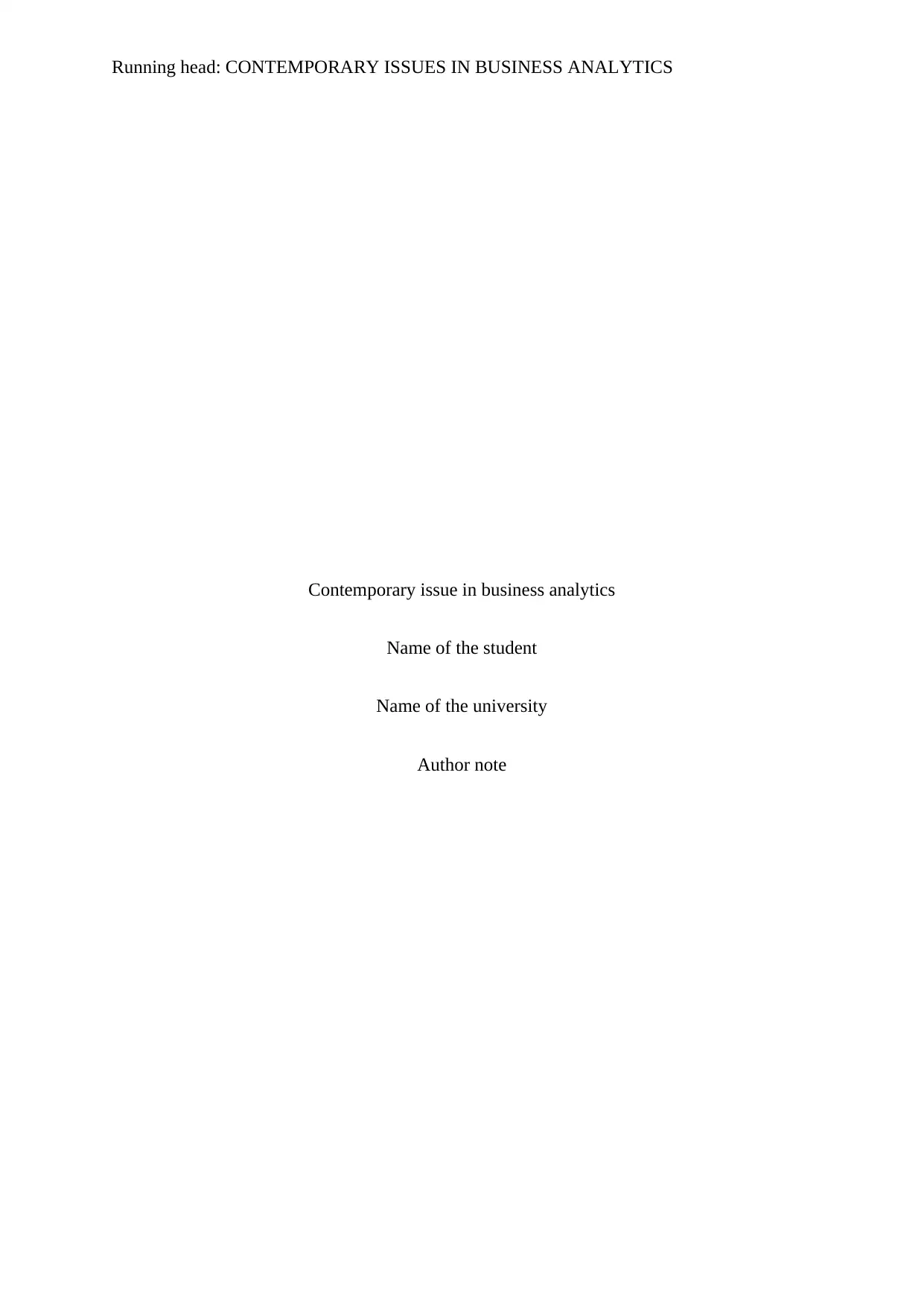
Running head: CONTEMPORARY ISSUES IN BUSINESS ANALYTICS
Contemporary issue in business analytics
Name of the student
Name of the university
Author note
Contemporary issue in business analytics
Name of the student
Name of the university
Author note
Paraphrase This Document
Need a fresh take? Get an instant paraphrase of this document with our AI Paraphraser
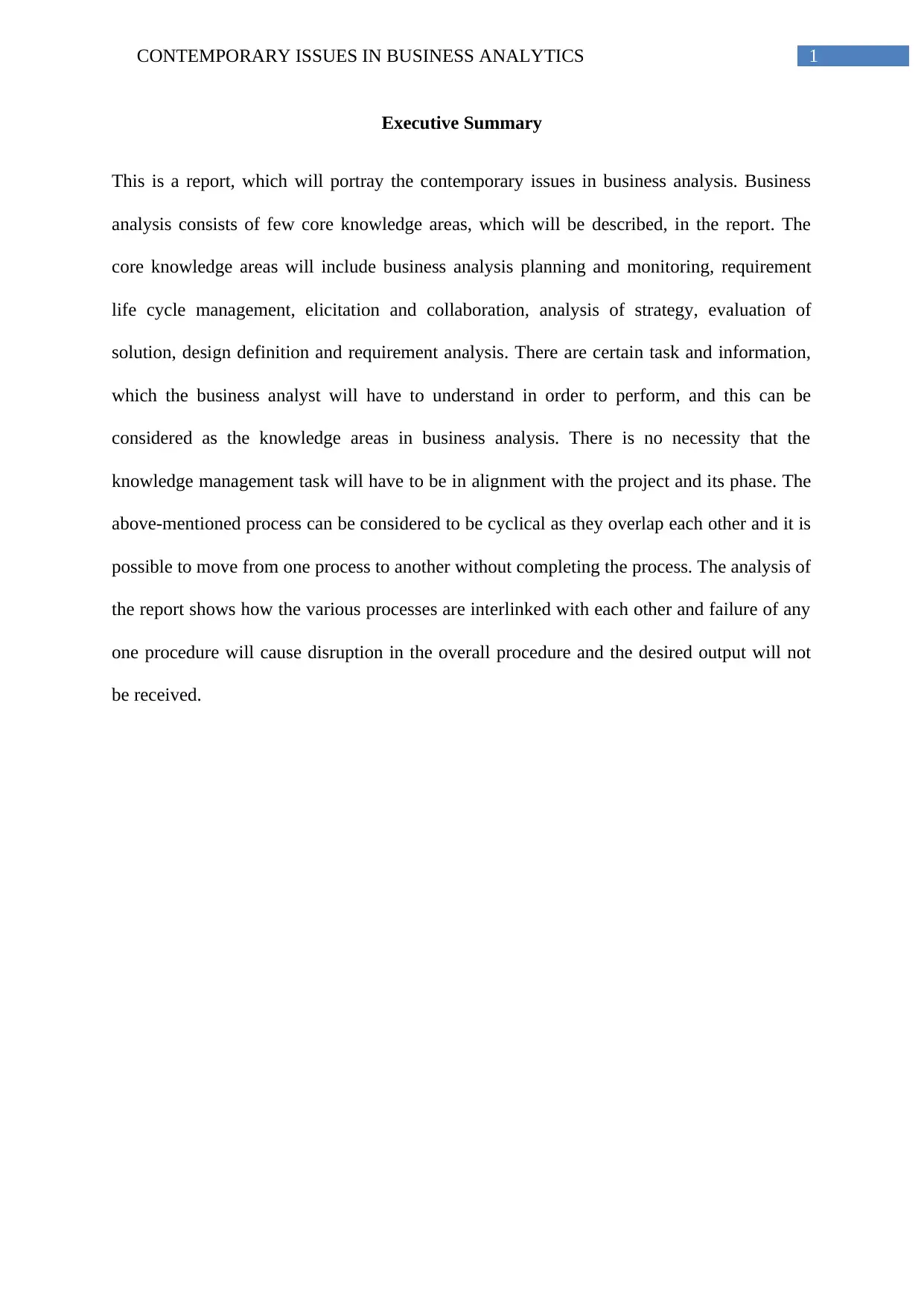
1CONTEMPORARY ISSUES IN BUSINESS ANALYTICS
Executive Summary
This is a report, which will portray the contemporary issues in business analysis. Business
analysis consists of few core knowledge areas, which will be described, in the report. The
core knowledge areas will include business analysis planning and monitoring, requirement
life cycle management, elicitation and collaboration, analysis of strategy, evaluation of
solution, design definition and requirement analysis. There are certain task and information,
which the business analyst will have to understand in order to perform, and this can be
considered as the knowledge areas in business analysis. There is no necessity that the
knowledge management task will have to be in alignment with the project and its phase. The
above-mentioned process can be considered to be cyclical as they overlap each other and it is
possible to move from one process to another without completing the process. The analysis of
the report shows how the various processes are interlinked with each other and failure of any
one procedure will cause disruption in the overall procedure and the desired output will not
be received.
Executive Summary
This is a report, which will portray the contemporary issues in business analysis. Business
analysis consists of few core knowledge areas, which will be described, in the report. The
core knowledge areas will include business analysis planning and monitoring, requirement
life cycle management, elicitation and collaboration, analysis of strategy, evaluation of
solution, design definition and requirement analysis. There are certain task and information,
which the business analyst will have to understand in order to perform, and this can be
considered as the knowledge areas in business analysis. There is no necessity that the
knowledge management task will have to be in alignment with the project and its phase. The
above-mentioned process can be considered to be cyclical as they overlap each other and it is
possible to move from one process to another without completing the process. The analysis of
the report shows how the various processes are interlinked with each other and failure of any
one procedure will cause disruption in the overall procedure and the desired output will not
be received.
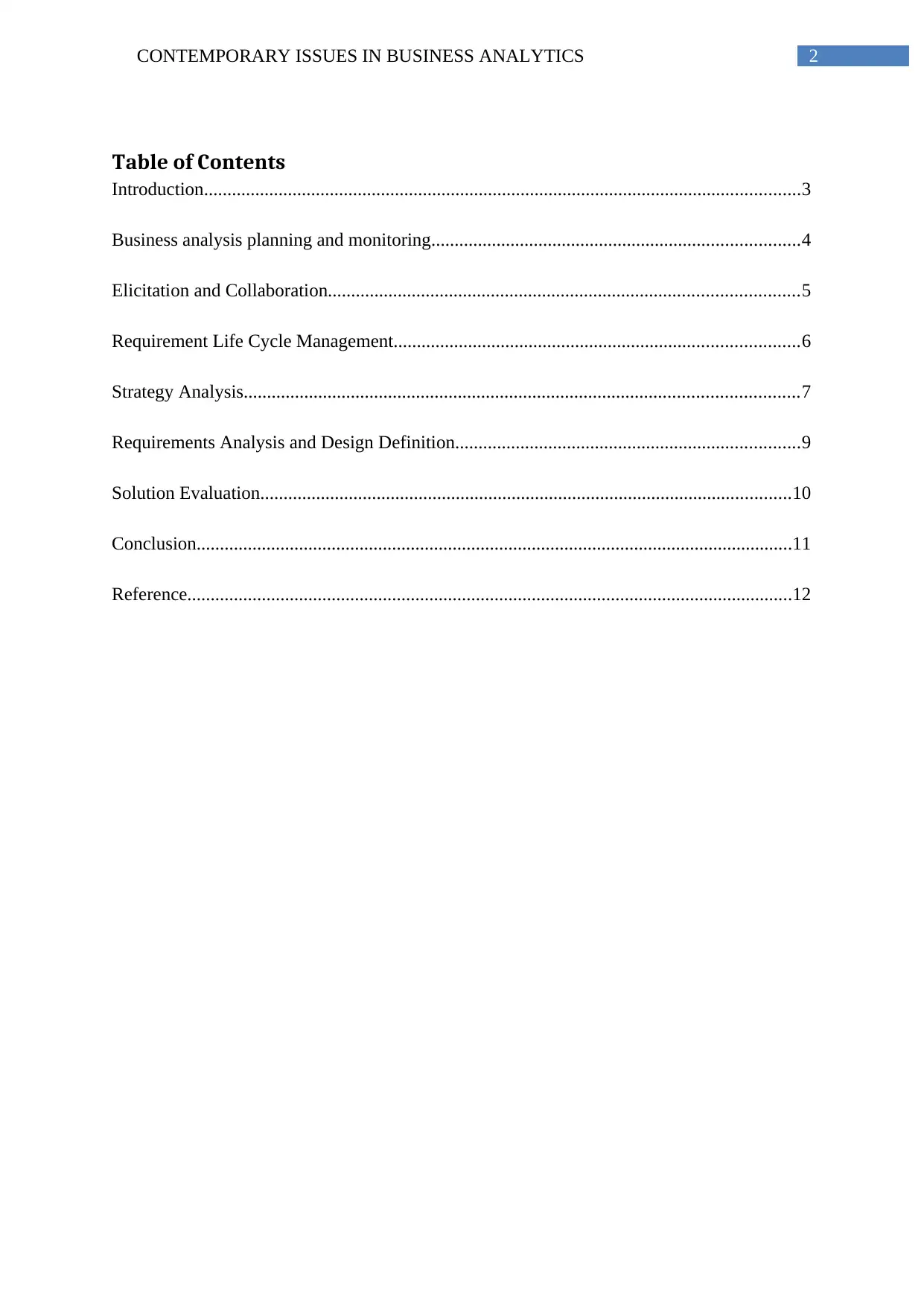
2CONTEMPORARY ISSUES IN BUSINESS ANALYTICS
Table of Contents
Introduction................................................................................................................................3
Business analysis planning and monitoring...............................................................................4
Elicitation and Collaboration.....................................................................................................5
Requirement Life Cycle Management.......................................................................................6
Strategy Analysis.......................................................................................................................7
Requirements Analysis and Design Definition..........................................................................9
Solution Evaluation..................................................................................................................10
Conclusion................................................................................................................................11
Reference..................................................................................................................................12
Table of Contents
Introduction................................................................................................................................3
Business analysis planning and monitoring...............................................................................4
Elicitation and Collaboration.....................................................................................................5
Requirement Life Cycle Management.......................................................................................6
Strategy Analysis.......................................................................................................................7
Requirements Analysis and Design Definition..........................................................................9
Solution Evaluation..................................................................................................................10
Conclusion................................................................................................................................11
Reference..................................................................................................................................12
⊘ This is a preview!⊘
Do you want full access?
Subscribe today to unlock all pages.

Trusted by 1+ million students worldwide
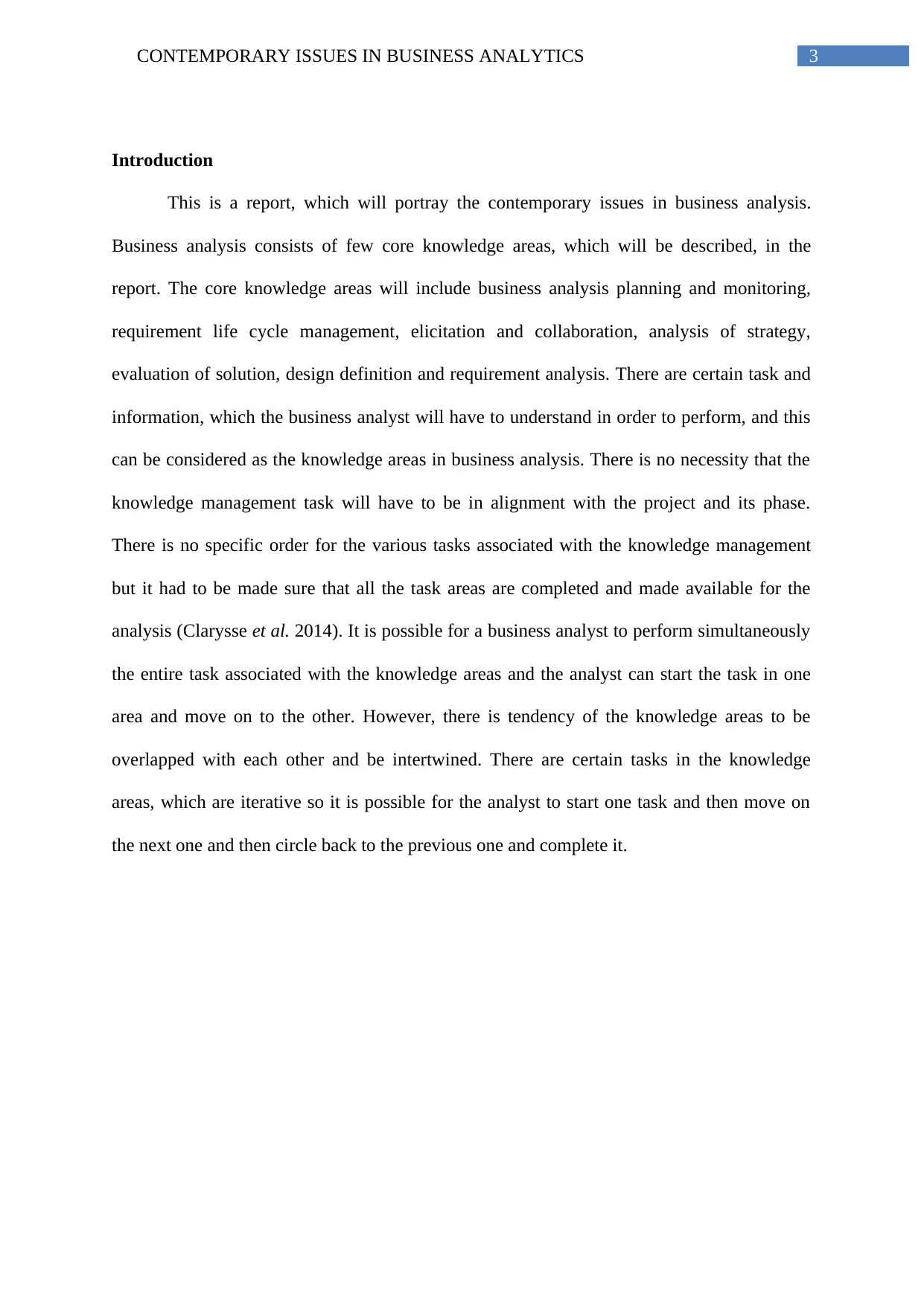
3CONTEMPORARY ISSUES IN BUSINESS ANALYTICS
Introduction
This is a report, which will portray the contemporary issues in business analysis.
Business analysis consists of few core knowledge areas, which will be described, in the
report. The core knowledge areas will include business analysis planning and monitoring,
requirement life cycle management, elicitation and collaboration, analysis of strategy,
evaluation of solution, design definition and requirement analysis. There are certain task and
information, which the business analyst will have to understand in order to perform, and this
can be considered as the knowledge areas in business analysis. There is no necessity that the
knowledge management task will have to be in alignment with the project and its phase.
There is no specific order for the various tasks associated with the knowledge management
but it had to be made sure that all the task areas are completed and made available for the
analysis (Clarysse et al. 2014). It is possible for a business analyst to perform simultaneously
the entire task associated with the knowledge areas and the analyst can start the task in one
area and move on to the other. However, there is tendency of the knowledge areas to be
overlapped with each other and be intertwined. There are certain tasks in the knowledge
areas, which are iterative so it is possible for the analyst to start one task and then move on
the next one and then circle back to the previous one and complete it.
Introduction
This is a report, which will portray the contemporary issues in business analysis.
Business analysis consists of few core knowledge areas, which will be described, in the
report. The core knowledge areas will include business analysis planning and monitoring,
requirement life cycle management, elicitation and collaboration, analysis of strategy,
evaluation of solution, design definition and requirement analysis. There are certain task and
information, which the business analyst will have to understand in order to perform, and this
can be considered as the knowledge areas in business analysis. There is no necessity that the
knowledge management task will have to be in alignment with the project and its phase.
There is no specific order for the various tasks associated with the knowledge management
but it had to be made sure that all the task areas are completed and made available for the
analysis (Clarysse et al. 2014). It is possible for a business analyst to perform simultaneously
the entire task associated with the knowledge areas and the analyst can start the task in one
area and move on to the other. However, there is tendency of the knowledge areas to be
overlapped with each other and be intertwined. There are certain tasks in the knowledge
areas, which are iterative so it is possible for the analyst to start one task and then move on
the next one and then circle back to the previous one and complete it.
Paraphrase This Document
Need a fresh take? Get an instant paraphrase of this document with our AI Paraphraser
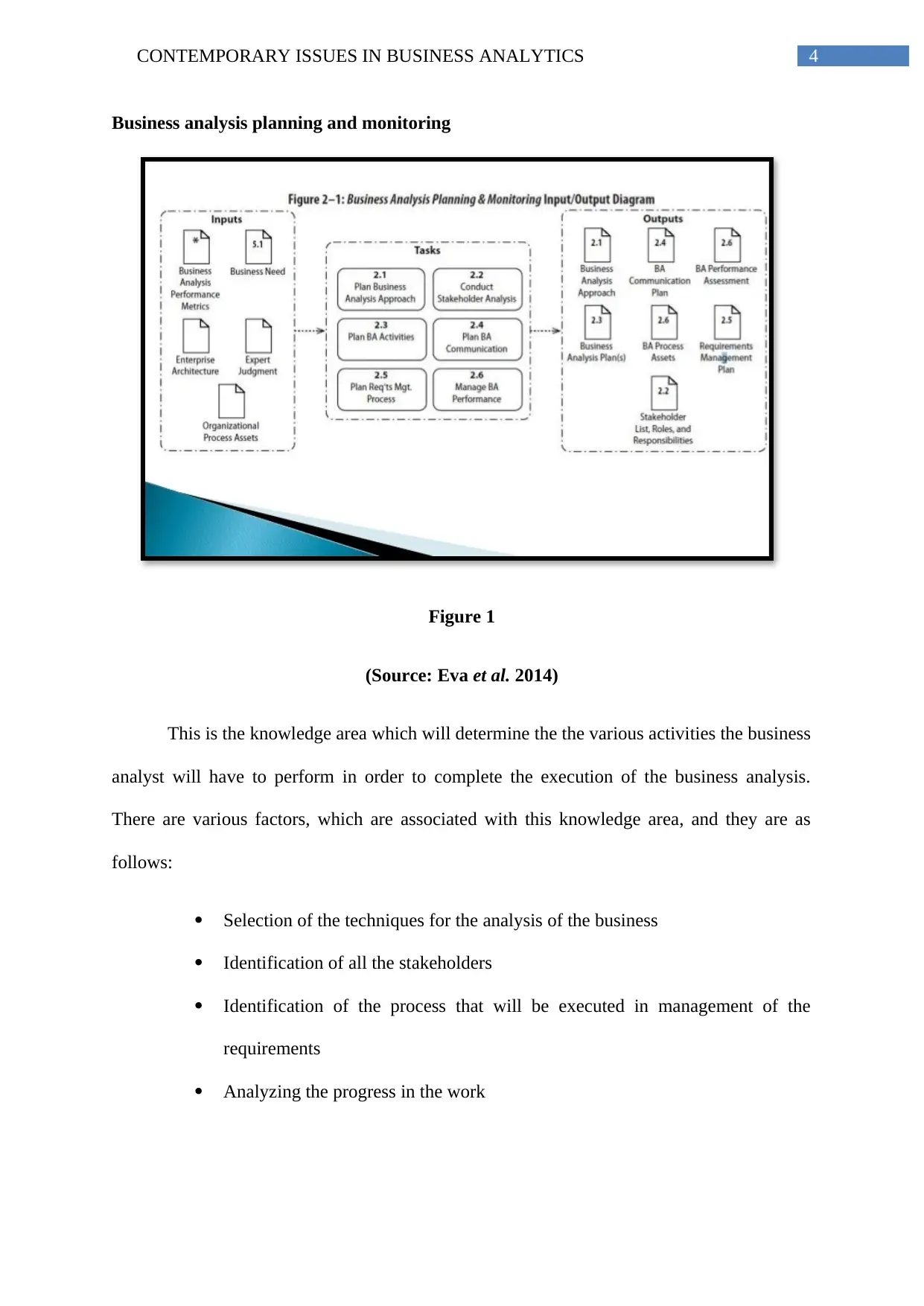
4CONTEMPORARY ISSUES IN BUSINESS ANALYTICS
Business analysis planning and monitoring
Figure 1
(Source: Eva et al. 2014)
This is the knowledge area which will determine the the various activities the business
analyst will have to perform in order to complete the execution of the business analysis.
There are various factors, which are associated with this knowledge area, and they are as
follows:
Selection of the techniques for the analysis of the business
Identification of all the stakeholders
Identification of the process that will be executed in management of the
requirements
Analyzing the progress in the work
Business analysis planning and monitoring
Figure 1
(Source: Eva et al. 2014)
This is the knowledge area which will determine the the various activities the business
analyst will have to perform in order to complete the execution of the business analysis.
There are various factors, which are associated with this knowledge area, and they are as
follows:
Selection of the techniques for the analysis of the business
Identification of all the stakeholders
Identification of the process that will be executed in management of the
requirements
Analyzing the progress in the work
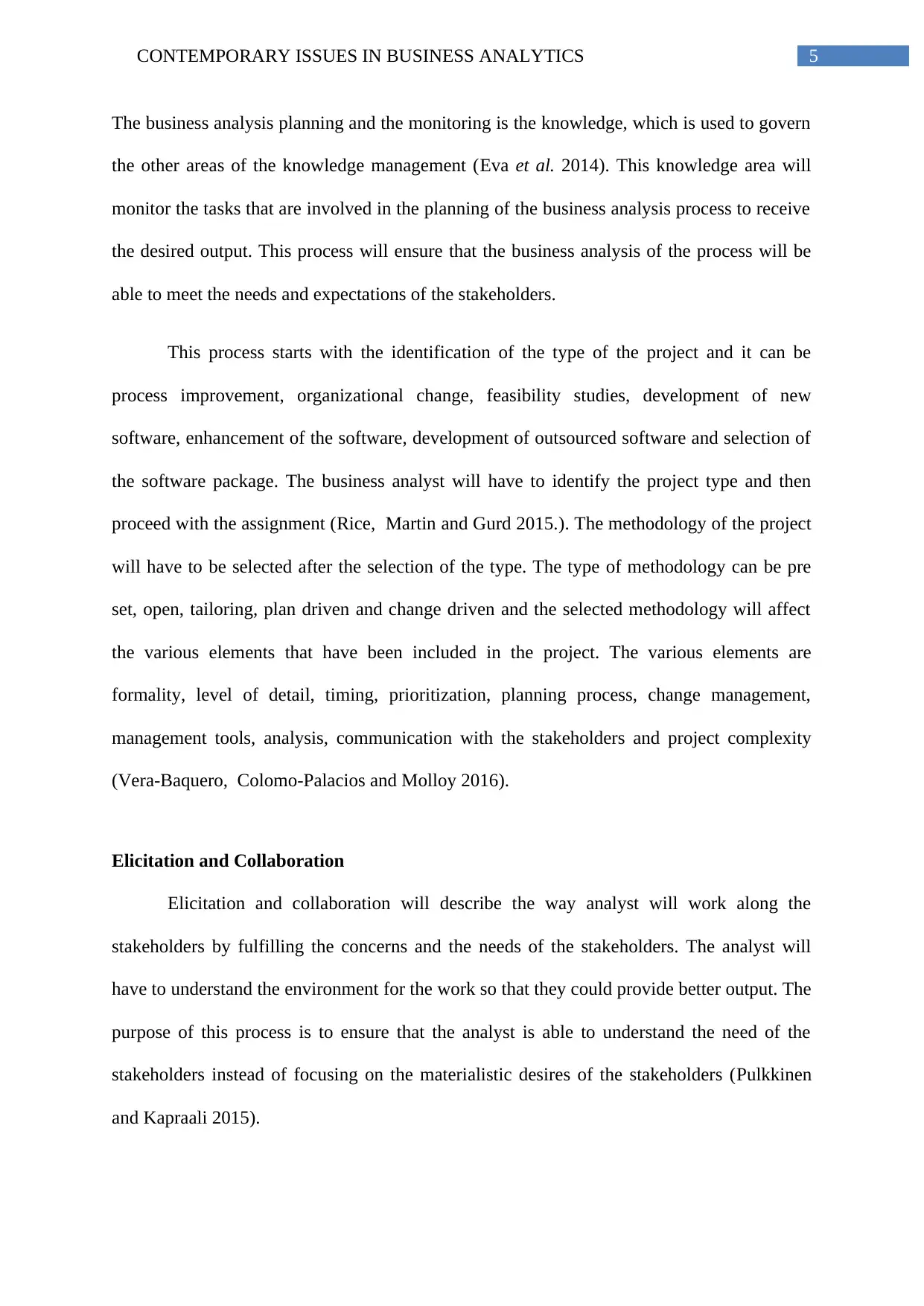
5CONTEMPORARY ISSUES IN BUSINESS ANALYTICS
The business analysis planning and the monitoring is the knowledge, which is used to govern
the other areas of the knowledge management (Eva et al. 2014). This knowledge area will
monitor the tasks that are involved in the planning of the business analysis process to receive
the desired output. This process will ensure that the business analysis of the process will be
able to meet the needs and expectations of the stakeholders.
This process starts with the identification of the type of the project and it can be
process improvement, organizational change, feasibility studies, development of new
software, enhancement of the software, development of outsourced software and selection of
the software package. The business analyst will have to identify the project type and then
proceed with the assignment (Rice, Martin and Gurd 2015.). The methodology of the project
will have to be selected after the selection of the type. The type of methodology can be pre
set, open, tailoring, plan driven and change driven and the selected methodology will affect
the various elements that have been included in the project. The various elements are
formality, level of detail, timing, prioritization, planning process, change management,
management tools, analysis, communication with the stakeholders and project complexity
(Vera-Baquero, Colomo-Palacios and Molloy 2016).
Elicitation and Collaboration
Elicitation and collaboration will describe the way analyst will work along the
stakeholders by fulfilling the concerns and the needs of the stakeholders. The analyst will
have to understand the environment for the work so that they could provide better output. The
purpose of this process is to ensure that the analyst is able to understand the need of the
stakeholders instead of focusing on the materialistic desires of the stakeholders (Pulkkinen
and Kapraali 2015).
The business analysis planning and the monitoring is the knowledge, which is used to govern
the other areas of the knowledge management (Eva et al. 2014). This knowledge area will
monitor the tasks that are involved in the planning of the business analysis process to receive
the desired output. This process will ensure that the business analysis of the process will be
able to meet the needs and expectations of the stakeholders.
This process starts with the identification of the type of the project and it can be
process improvement, organizational change, feasibility studies, development of new
software, enhancement of the software, development of outsourced software and selection of
the software package. The business analyst will have to identify the project type and then
proceed with the assignment (Rice, Martin and Gurd 2015.). The methodology of the project
will have to be selected after the selection of the type. The type of methodology can be pre
set, open, tailoring, plan driven and change driven and the selected methodology will affect
the various elements that have been included in the project. The various elements are
formality, level of detail, timing, prioritization, planning process, change management,
management tools, analysis, communication with the stakeholders and project complexity
(Vera-Baquero, Colomo-Palacios and Molloy 2016).
Elicitation and Collaboration
Elicitation and collaboration will describe the way analyst will work along the
stakeholders by fulfilling the concerns and the needs of the stakeholders. The analyst will
have to understand the environment for the work so that they could provide better output. The
purpose of this process is to ensure that the analyst is able to understand the need of the
stakeholders instead of focusing on the materialistic desires of the stakeholders (Pulkkinen
and Kapraali 2015).
⊘ This is a preview!⊘
Do you want full access?
Subscribe today to unlock all pages.

Trusted by 1+ million students worldwide
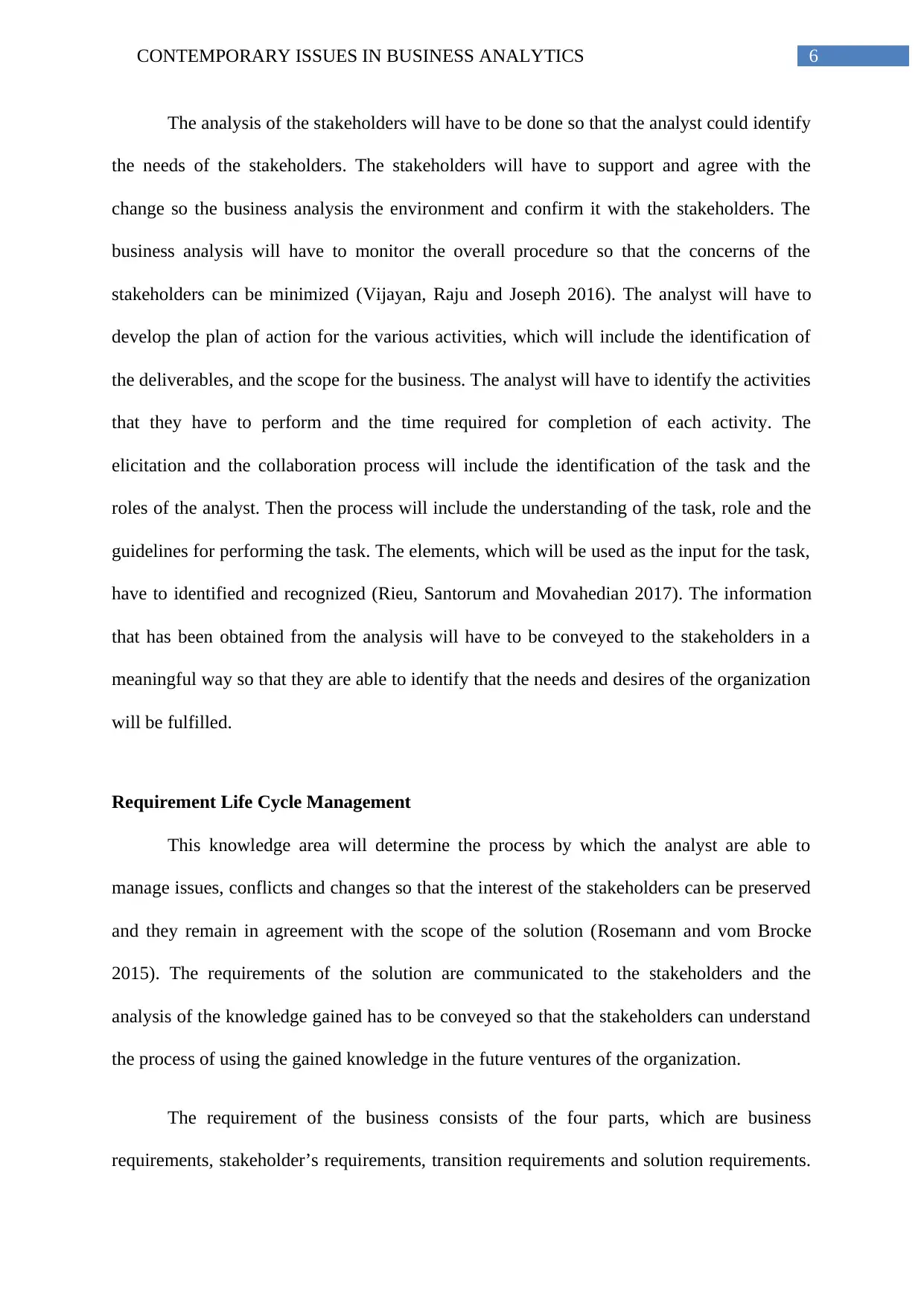
6CONTEMPORARY ISSUES IN BUSINESS ANALYTICS
The analysis of the stakeholders will have to be done so that the analyst could identify
the needs of the stakeholders. The stakeholders will have to support and agree with the
change so the business analysis the environment and confirm it with the stakeholders. The
business analysis will have to monitor the overall procedure so that the concerns of the
stakeholders can be minimized (Vijayan, Raju and Joseph 2016). The analyst will have to
develop the plan of action for the various activities, which will include the identification of
the deliverables, and the scope for the business. The analyst will have to identify the activities
that they have to perform and the time required for completion of each activity. The
elicitation and the collaboration process will include the identification of the task and the
roles of the analyst. Then the process will include the understanding of the task, role and the
guidelines for performing the task. The elements, which will be used as the input for the task,
have to identified and recognized (Rieu, Santorum and Movahedian 2017). The information
that has been obtained from the analysis will have to be conveyed to the stakeholders in a
meaningful way so that they are able to identify that the needs and desires of the organization
will be fulfilled.
Requirement Life Cycle Management
This knowledge area will determine the process by which the analyst are able to
manage issues, conflicts and changes so that the interest of the stakeholders can be preserved
and they remain in agreement with the scope of the solution (Rosemann and vom Brocke
2015). The requirements of the solution are communicated to the stakeholders and the
analysis of the knowledge gained has to be conveyed so that the stakeholders can understand
the process of using the gained knowledge in the future ventures of the organization.
The requirement of the business consists of the four parts, which are business
requirements, stakeholder’s requirements, transition requirements and solution requirements.
The analysis of the stakeholders will have to be done so that the analyst could identify
the needs of the stakeholders. The stakeholders will have to support and agree with the
change so the business analysis the environment and confirm it with the stakeholders. The
business analysis will have to monitor the overall procedure so that the concerns of the
stakeholders can be minimized (Vijayan, Raju and Joseph 2016). The analyst will have to
develop the plan of action for the various activities, which will include the identification of
the deliverables, and the scope for the business. The analyst will have to identify the activities
that they have to perform and the time required for completion of each activity. The
elicitation and the collaboration process will include the identification of the task and the
roles of the analyst. Then the process will include the understanding of the task, role and the
guidelines for performing the task. The elements, which will be used as the input for the task,
have to identified and recognized (Rieu, Santorum and Movahedian 2017). The information
that has been obtained from the analysis will have to be conveyed to the stakeholders in a
meaningful way so that they are able to identify that the needs and desires of the organization
will be fulfilled.
Requirement Life Cycle Management
This knowledge area will determine the process by which the analyst are able to
manage issues, conflicts and changes so that the interest of the stakeholders can be preserved
and they remain in agreement with the scope of the solution (Rosemann and vom Brocke
2015). The requirements of the solution are communicated to the stakeholders and the
analysis of the knowledge gained has to be conveyed so that the stakeholders can understand
the process of using the gained knowledge in the future ventures of the organization.
The requirement of the business consists of the four parts, which are business
requirements, stakeholder’s requirements, transition requirements and solution requirements.
Paraphrase This Document
Need a fresh take? Get an instant paraphrase of this document with our AI Paraphraser
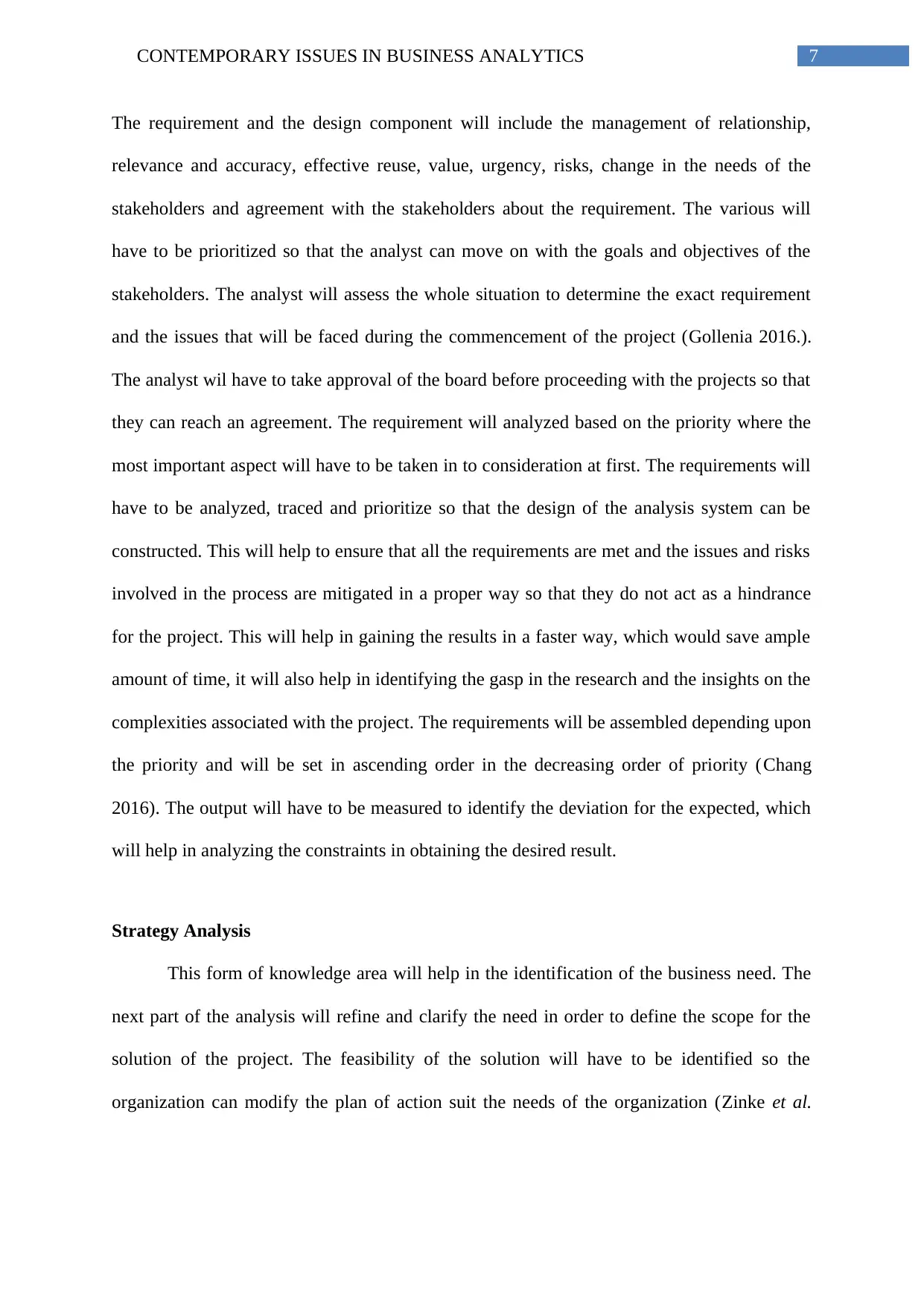
7CONTEMPORARY ISSUES IN BUSINESS ANALYTICS
The requirement and the design component will include the management of relationship,
relevance and accuracy, effective reuse, value, urgency, risks, change in the needs of the
stakeholders and agreement with the stakeholders about the requirement. The various will
have to be prioritized so that the analyst can move on with the goals and objectives of the
stakeholders. The analyst will assess the whole situation to determine the exact requirement
and the issues that will be faced during the commencement of the project (Gollenia 2016.).
The analyst wil have to take approval of the board before proceeding with the projects so that
they can reach an agreement. The requirement will analyzed based on the priority where the
most important aspect will have to be taken in to consideration at first. The requirements will
have to be analyzed, traced and prioritize so that the design of the analysis system can be
constructed. This will help to ensure that all the requirements are met and the issues and risks
involved in the process are mitigated in a proper way so that they do not act as a hindrance
for the project. This will help in gaining the results in a faster way, which would save ample
amount of time, it will also help in identifying the gasp in the research and the insights on the
complexities associated with the project. The requirements will be assembled depending upon
the priority and will be set in ascending order in the decreasing order of priority (Chang
2016). The output will have to be measured to identify the deviation for the expected, which
will help in analyzing the constraints in obtaining the desired result.
Strategy Analysis
This form of knowledge area will help in the identification of the business need. The
next part of the analysis will refine and clarify the need in order to define the scope for the
solution of the project. The feasibility of the solution will have to be identified so the
organization can modify the plan of action suit the needs of the organization (Zinke et al.
The requirement and the design component will include the management of relationship,
relevance and accuracy, effective reuse, value, urgency, risks, change in the needs of the
stakeholders and agreement with the stakeholders about the requirement. The various will
have to be prioritized so that the analyst can move on with the goals and objectives of the
stakeholders. The analyst will assess the whole situation to determine the exact requirement
and the issues that will be faced during the commencement of the project (Gollenia 2016.).
The analyst wil have to take approval of the board before proceeding with the projects so that
they can reach an agreement. The requirement will analyzed based on the priority where the
most important aspect will have to be taken in to consideration at first. The requirements will
have to be analyzed, traced and prioritize so that the design of the analysis system can be
constructed. This will help to ensure that all the requirements are met and the issues and risks
involved in the process are mitigated in a proper way so that they do not act as a hindrance
for the project. This will help in gaining the results in a faster way, which would save ample
amount of time, it will also help in identifying the gasp in the research and the insights on the
complexities associated with the project. The requirements will be assembled depending upon
the priority and will be set in ascending order in the decreasing order of priority (Chang
2016). The output will have to be measured to identify the deviation for the expected, which
will help in analyzing the constraints in obtaining the desired result.
Strategy Analysis
This form of knowledge area will help in the identification of the business need. The
next part of the analysis will refine and clarify the need in order to define the scope for the
solution of the project. The feasibility of the solution will have to be identified so the
organization can modify the plan of action suit the needs of the organization (Zinke et al.
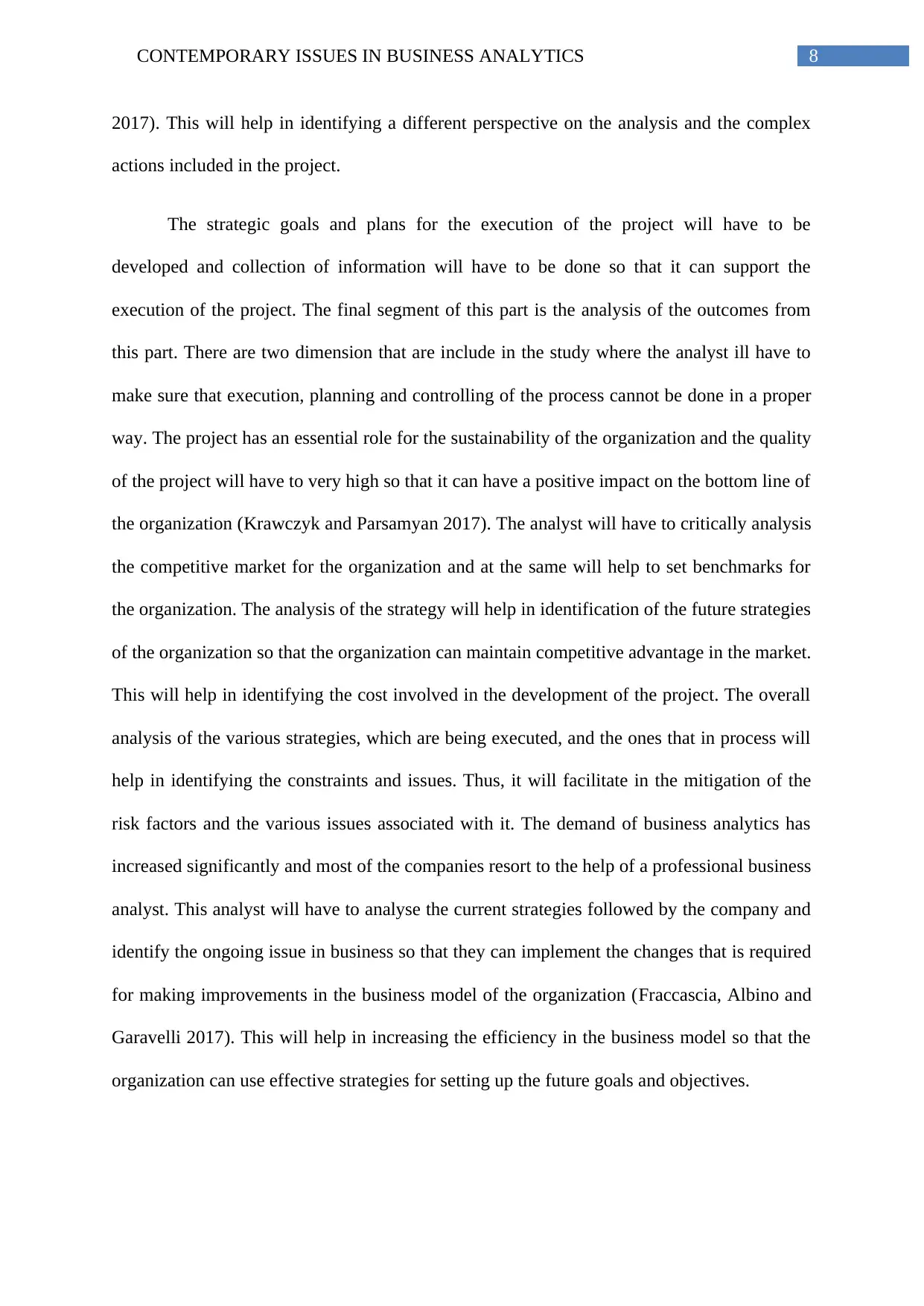
8CONTEMPORARY ISSUES IN BUSINESS ANALYTICS
2017). This will help in identifying a different perspective on the analysis and the complex
actions included in the project.
The strategic goals and plans for the execution of the project will have to be
developed and collection of information will have to be done so that it can support the
execution of the project. The final segment of this part is the analysis of the outcomes from
this part. There are two dimension that are include in the study where the analyst ill have to
make sure that execution, planning and controlling of the process cannot be done in a proper
way. The project has an essential role for the sustainability of the organization and the quality
of the project will have to very high so that it can have a positive impact on the bottom line of
the organization (Krawczyk and Parsamyan 2017). The analyst will have to critically analysis
the competitive market for the organization and at the same will help to set benchmarks for
the organization. The analysis of the strategy will help in identification of the future strategies
of the organization so that the organization can maintain competitive advantage in the market.
This will help in identifying the cost involved in the development of the project. The overall
analysis of the various strategies, which are being executed, and the ones that in process will
help in identifying the constraints and issues. Thus, it will facilitate in the mitigation of the
risk factors and the various issues associated with it. The demand of business analytics has
increased significantly and most of the companies resort to the help of a professional business
analyst. This analyst will have to analyse the current strategies followed by the company and
identify the ongoing issue in business so that they can implement the changes that is required
for making improvements in the business model of the organization (Fraccascia, Albino and
Garavelli 2017). This will help in increasing the efficiency in the business model so that the
organization can use effective strategies for setting up the future goals and objectives.
2017). This will help in identifying a different perspective on the analysis and the complex
actions included in the project.
The strategic goals and plans for the execution of the project will have to be
developed and collection of information will have to be done so that it can support the
execution of the project. The final segment of this part is the analysis of the outcomes from
this part. There are two dimension that are include in the study where the analyst ill have to
make sure that execution, planning and controlling of the process cannot be done in a proper
way. The project has an essential role for the sustainability of the organization and the quality
of the project will have to very high so that it can have a positive impact on the bottom line of
the organization (Krawczyk and Parsamyan 2017). The analyst will have to critically analysis
the competitive market for the organization and at the same will help to set benchmarks for
the organization. The analysis of the strategy will help in identification of the future strategies
of the organization so that the organization can maintain competitive advantage in the market.
This will help in identifying the cost involved in the development of the project. The overall
analysis of the various strategies, which are being executed, and the ones that in process will
help in identifying the constraints and issues. Thus, it will facilitate in the mitigation of the
risk factors and the various issues associated with it. The demand of business analytics has
increased significantly and most of the companies resort to the help of a professional business
analyst. This analyst will have to analyse the current strategies followed by the company and
identify the ongoing issue in business so that they can implement the changes that is required
for making improvements in the business model of the organization (Fraccascia, Albino and
Garavelli 2017). This will help in increasing the efficiency in the business model so that the
organization can use effective strategies for setting up the future goals and objectives.
⊘ This is a preview!⊘
Do you want full access?
Subscribe today to unlock all pages.

Trusted by 1+ million students worldwide
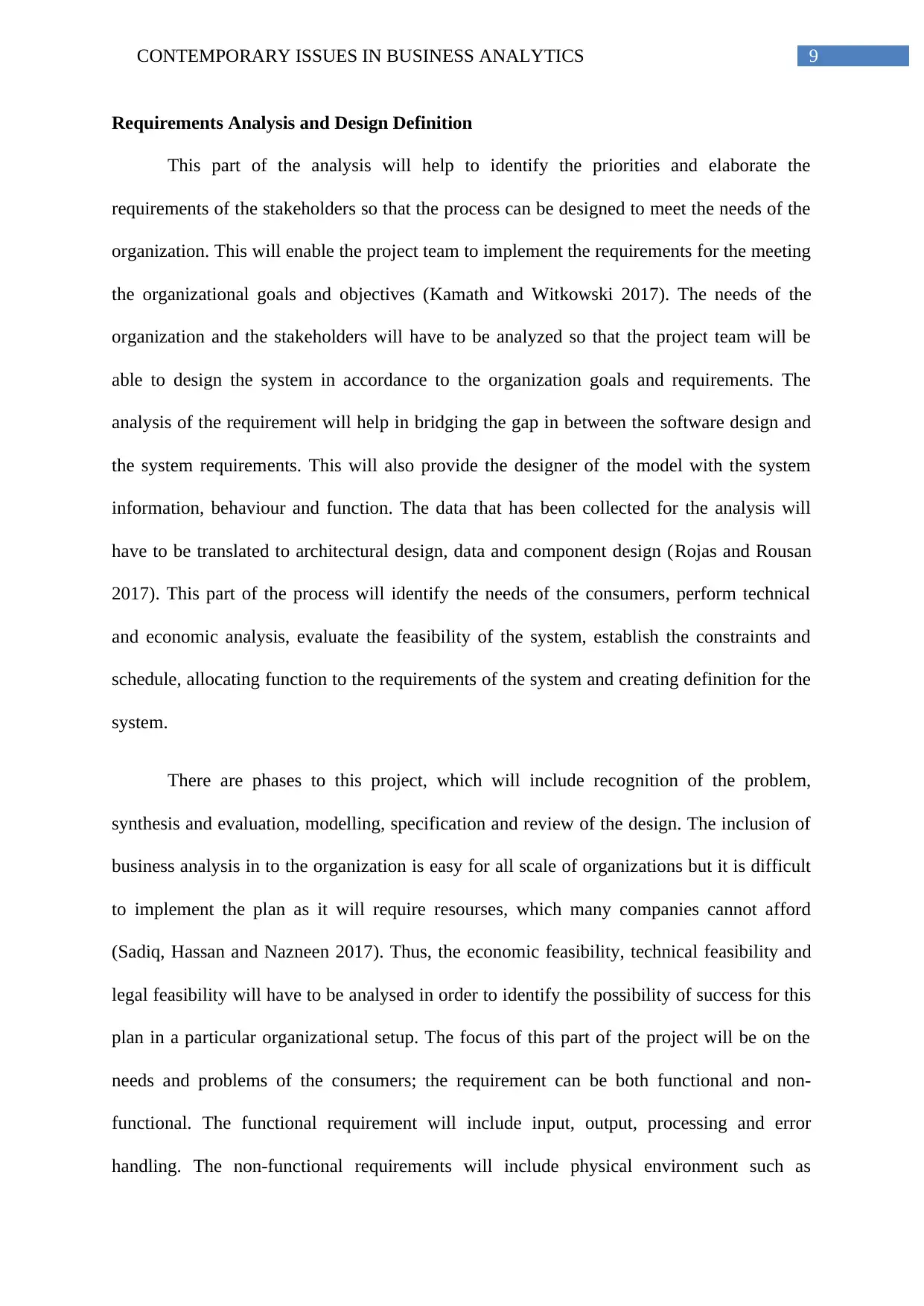
9CONTEMPORARY ISSUES IN BUSINESS ANALYTICS
Requirements Analysis and Design Definition
This part of the analysis will help to identify the priorities and elaborate the
requirements of the stakeholders so that the process can be designed to meet the needs of the
organization. This will enable the project team to implement the requirements for the meeting
the organizational goals and objectives (Kamath and Witkowski 2017). The needs of the
organization and the stakeholders will have to be analyzed so that the project team will be
able to design the system in accordance to the organization goals and requirements. The
analysis of the requirement will help in bridging the gap in between the software design and
the system requirements. This will also provide the designer of the model with the system
information, behaviour and function. The data that has been collected for the analysis will
have to be translated to architectural design, data and component design (Rojas and Rousan
2017). This part of the process will identify the needs of the consumers, perform technical
and economic analysis, evaluate the feasibility of the system, establish the constraints and
schedule, allocating function to the requirements of the system and creating definition for the
system.
There are phases to this project, which will include recognition of the problem,
synthesis and evaluation, modelling, specification and review of the design. The inclusion of
business analysis in to the organization is easy for all scale of organizations but it is difficult
to implement the plan as it will require resourses, which many companies cannot afford
(Sadiq, Hassan and Nazneen 2017). Thus, the economic feasibility, technical feasibility and
legal feasibility will have to be analysed in order to identify the possibility of success for this
plan in a particular organizational setup. The focus of this part of the project will be on the
needs and problems of the consumers; the requirement can be both functional and non-
functional. The functional requirement will include input, output, processing and error
handling. The non-functional requirements will include physical environment such as
Requirements Analysis and Design Definition
This part of the analysis will help to identify the priorities and elaborate the
requirements of the stakeholders so that the process can be designed to meet the needs of the
organization. This will enable the project team to implement the requirements for the meeting
the organizational goals and objectives (Kamath and Witkowski 2017). The needs of the
organization and the stakeholders will have to be analyzed so that the project team will be
able to design the system in accordance to the organization goals and requirements. The
analysis of the requirement will help in bridging the gap in between the software design and
the system requirements. This will also provide the designer of the model with the system
information, behaviour and function. The data that has been collected for the analysis will
have to be translated to architectural design, data and component design (Rojas and Rousan
2017). This part of the process will identify the needs of the consumers, perform technical
and economic analysis, evaluate the feasibility of the system, establish the constraints and
schedule, allocating function to the requirements of the system and creating definition for the
system.
There are phases to this project, which will include recognition of the problem,
synthesis and evaluation, modelling, specification and review of the design. The inclusion of
business analysis in to the organization is easy for all scale of organizations but it is difficult
to implement the plan as it will require resourses, which many companies cannot afford
(Sadiq, Hassan and Nazneen 2017). Thus, the economic feasibility, technical feasibility and
legal feasibility will have to be analysed in order to identify the possibility of success for this
plan in a particular organizational setup. The focus of this part of the project will be on the
needs and problems of the consumers; the requirement can be both functional and non-
functional. The functional requirement will include input, output, processing and error
handling. The non-functional requirements will include physical environment such as
Paraphrase This Document
Need a fresh take? Get an instant paraphrase of this document with our AI Paraphraser
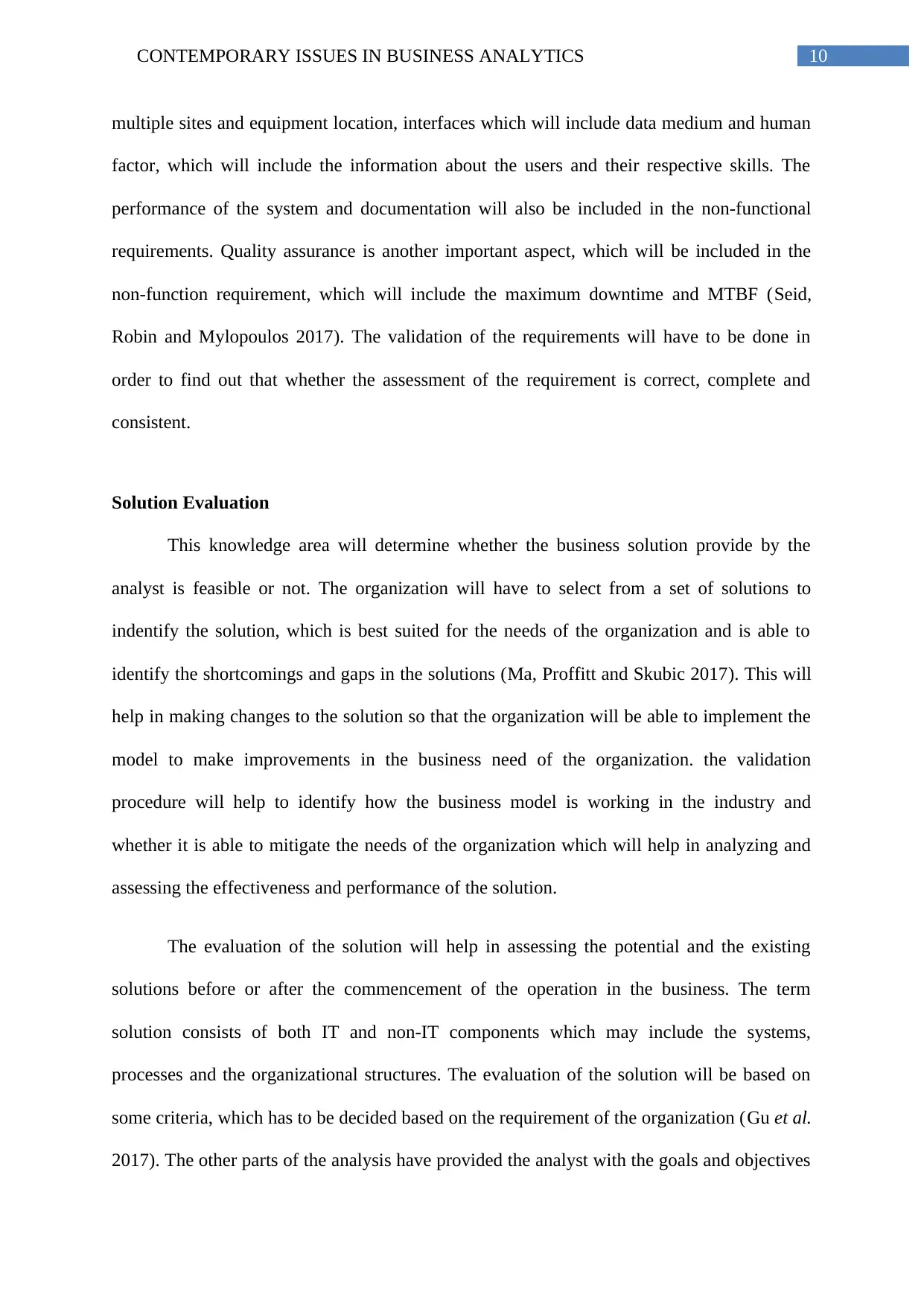
10CONTEMPORARY ISSUES IN BUSINESS ANALYTICS
multiple sites and equipment location, interfaces which will include data medium and human
factor, which will include the information about the users and their respective skills. The
performance of the system and documentation will also be included in the non-functional
requirements. Quality assurance is another important aspect, which will be included in the
non-function requirement, which will include the maximum downtime and MTBF (Seid,
Robin and Mylopoulos 2017). The validation of the requirements will have to be done in
order to find out that whether the assessment of the requirement is correct, complete and
consistent.
Solution Evaluation
This knowledge area will determine whether the business solution provide by the
analyst is feasible or not. The organization will have to select from a set of solutions to
indentify the solution, which is best suited for the needs of the organization and is able to
identify the shortcomings and gaps in the solutions (Ma, Proffitt and Skubic 2017). This will
help in making changes to the solution so that the organization will be able to implement the
model to make improvements in the business need of the organization. the validation
procedure will help to identify how the business model is working in the industry and
whether it is able to mitigate the needs of the organization which will help in analyzing and
assessing the effectiveness and performance of the solution.
The evaluation of the solution will help in assessing the potential and the existing
solutions before or after the commencement of the operation in the business. The term
solution consists of both IT and non-IT components which may include the systems,
processes and the organizational structures. The evaluation of the solution will be based on
some criteria, which has to be decided based on the requirement of the organization (Gu et al.
2017). The other parts of the analysis have provided the analyst with the goals and objectives
multiple sites and equipment location, interfaces which will include data medium and human
factor, which will include the information about the users and their respective skills. The
performance of the system and documentation will also be included in the non-functional
requirements. Quality assurance is another important aspect, which will be included in the
non-function requirement, which will include the maximum downtime and MTBF (Seid,
Robin and Mylopoulos 2017). The validation of the requirements will have to be done in
order to find out that whether the assessment of the requirement is correct, complete and
consistent.
Solution Evaluation
This knowledge area will determine whether the business solution provide by the
analyst is feasible or not. The organization will have to select from a set of solutions to
indentify the solution, which is best suited for the needs of the organization and is able to
identify the shortcomings and gaps in the solutions (Ma, Proffitt and Skubic 2017). This will
help in making changes to the solution so that the organization will be able to implement the
model to make improvements in the business need of the organization. the validation
procedure will help to identify how the business model is working in the industry and
whether it is able to mitigate the needs of the organization which will help in analyzing and
assessing the effectiveness and performance of the solution.
The evaluation of the solution will help in assessing the potential and the existing
solutions before or after the commencement of the operation in the business. The term
solution consists of both IT and non-IT components which may include the systems,
processes and the organizational structures. The evaluation of the solution will be based on
some criteria, which has to be decided based on the requirement of the organization (Gu et al.
2017). The other parts of the analysis have provided the analyst with the goals and objectives
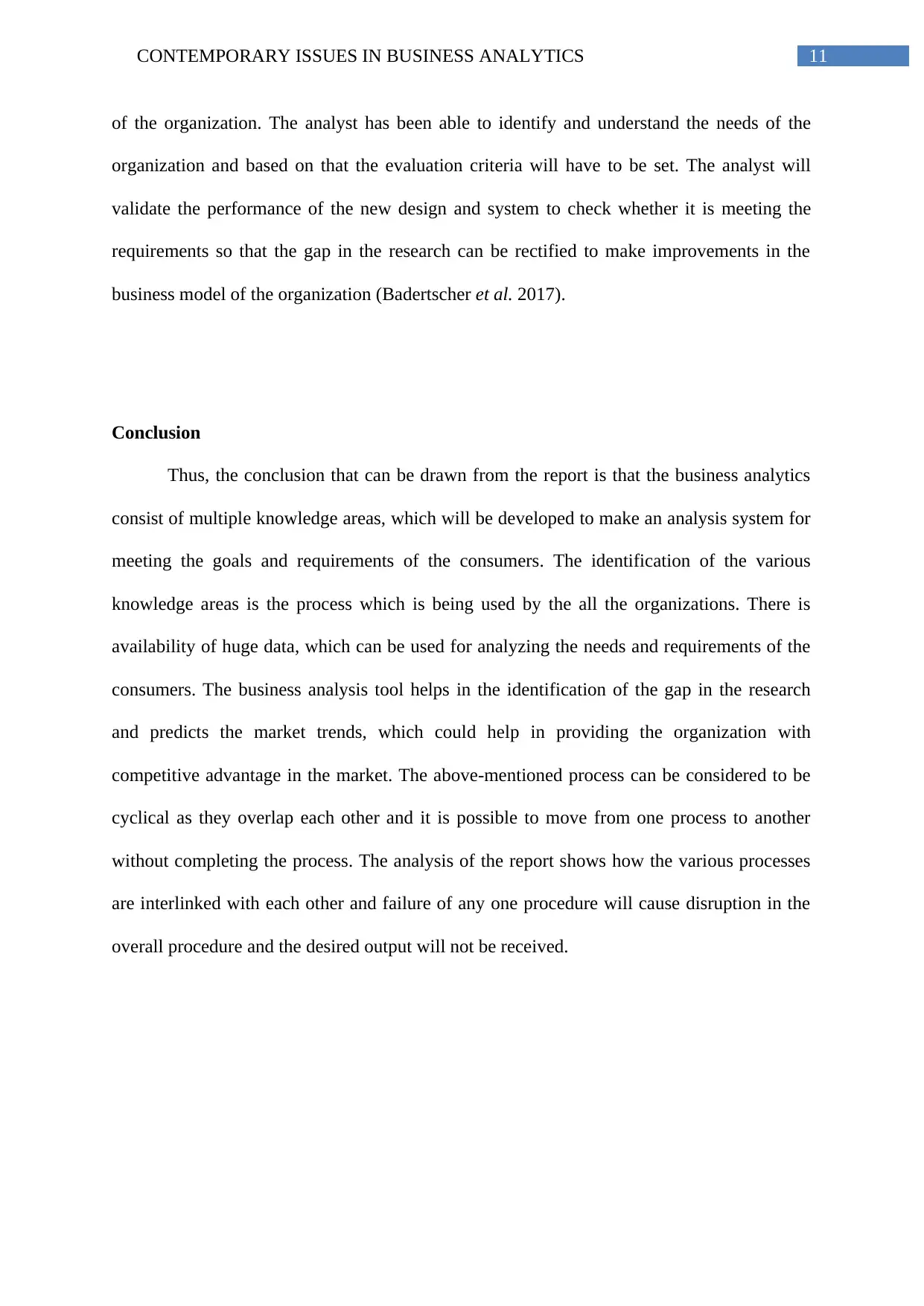
11CONTEMPORARY ISSUES IN BUSINESS ANALYTICS
of the organization. The analyst has been able to identify and understand the needs of the
organization and based on that the evaluation criteria will have to be set. The analyst will
validate the performance of the new design and system to check whether it is meeting the
requirements so that the gap in the research can be rectified to make improvements in the
business model of the organization (Badertscher et al. 2017).
Conclusion
Thus, the conclusion that can be drawn from the report is that the business analytics
consist of multiple knowledge areas, which will be developed to make an analysis system for
meeting the goals and requirements of the consumers. The identification of the various
knowledge areas is the process which is being used by the all the organizations. There is
availability of huge data, which can be used for analyzing the needs and requirements of the
consumers. The business analysis tool helps in the identification of the gap in the research
and predicts the market trends, which could help in providing the organization with
competitive advantage in the market. The above-mentioned process can be considered to be
cyclical as they overlap each other and it is possible to move from one process to another
without completing the process. The analysis of the report shows how the various processes
are interlinked with each other and failure of any one procedure will cause disruption in the
overall procedure and the desired output will not be received.
of the organization. The analyst has been able to identify and understand the needs of the
organization and based on that the evaluation criteria will have to be set. The analyst will
validate the performance of the new design and system to check whether it is meeting the
requirements so that the gap in the research can be rectified to make improvements in the
business model of the organization (Badertscher et al. 2017).
Conclusion
Thus, the conclusion that can be drawn from the report is that the business analytics
consist of multiple knowledge areas, which will be developed to make an analysis system for
meeting the goals and requirements of the consumers. The identification of the various
knowledge areas is the process which is being used by the all the organizations. There is
availability of huge data, which can be used for analyzing the needs and requirements of the
consumers. The business analysis tool helps in the identification of the gap in the research
and predicts the market trends, which could help in providing the organization with
competitive advantage in the market. The above-mentioned process can be considered to be
cyclical as they overlap each other and it is possible to move from one process to another
without completing the process. The analysis of the report shows how the various processes
are interlinked with each other and failure of any one procedure will cause disruption in the
overall procedure and the desired output will not be received.
⊘ This is a preview!⊘
Do you want full access?
Subscribe today to unlock all pages.

Trusted by 1+ million students worldwide
1 out of 15
Related Documents
Your All-in-One AI-Powered Toolkit for Academic Success.
+13062052269
info@desklib.com
Available 24*7 on WhatsApp / Email
![[object Object]](/_next/static/media/star-bottom.7253800d.svg)
Unlock your academic potential
Copyright © 2020–2025 A2Z Services. All Rights Reserved. Developed and managed by ZUCOL.





